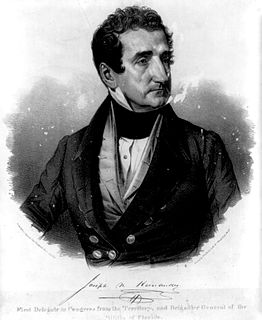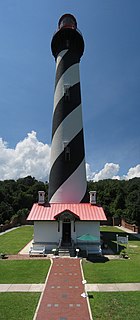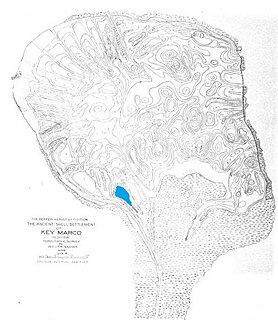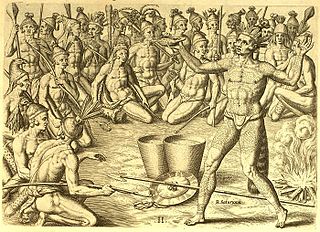Related Research Articles

St. Augustine is a city in the Southeastern United States, on the Atlantic coast of northeastern Florida. Founded in 1565 by Spanish explorers, it is the oldest continuously-inhabited European-established settlement in the contiguous United States.

The Florida Museum of Natural History (FLMNH) is Florida's official state-sponsored and chartered natural-history museum. Its main facilities are located at 3215 Hull Road on the campus of the University of Florida in Gainesville.

José Mariano Hernández or Joseph Marion Hernández was an American politician, plantation owner, and soldier. He was the first Delegate from the Florida Territory and the first Hispanic American to serve in the United States Congress. A member of the Whig Party, he served from September 1822 to March 1823.

The St. Augustine Light Station is a private-aid to navigation and an active, working lighthouse in St. Augustine, Florida. The current lighthouse stands at the north end of Anastasia Island and was built between 1871 and 1874. The tower is the second lighthouse tower in St. Augustine, the first being lit officially by the American territorial government in May 1824 as Florida's first lighthouse. However, both the Spanish and the British governments operated a major aid to navigation here including a series of wooden watch towers and beacons dating from 1565.

Key Marco was an archaeological site (8CR48) consisting of a large shell works island next to Marco Island, Florida. A small pond on Key Marco, now known as the "Court of the Pile Dwellers" (8CR49), was excavated in 1896 by the Smithsonian Institution's Pepper-Hearst Expedition, led by Frank Hamilton Cushing. Cushing recovered more than 1,000 wooden artifacts from the pond, the largest number of wooden artifacts from any prehistoric archaeological site in the eastern United States. These artifacts are described as some of the finest prehistoric Native American art in North America. The Key Marco materials are principally divided between the University of Pennsylvania Museum of Archaeology and Anthropology, University of Pennsylvania; the Department of Anthropology, National Museum of Natural History, Smithsonian Institution; and the Florida Museum of Natural History, University of Florida. The original pond was completely excavated and refilled. It is now covered by a housing subdivision. Excavations of small parts of the site were also conducted in 1965 and 1995.

Fort Mose Historic State Park is a U.S. National Historic Landmark, located two miles north of St. Augustine, Florida, on the edge of a salt marsh on the western side of the waterway separating the mainland from the coastal barrier islands. The original site of the 18th-century fort was uncovered in a 1986 archeological dig. The 24-acre (9.7 ha) site is now protected as a Florida State Park, administered through the Anastasia State Recreation Area. Fort Mose is the "premier site on the Florida Black Heritage Trail". In 1738, the Spanish governor of Florida, Manuel de Montiano, had Fort Mose constructed and established it as a free black settlement, the first to be legally sanctioned in what would become the territory of the United States. The fort has also been called Fort Moosa or Fort Mossa, variants of the Spanish pronunciation.
The Mocama were a Native American people who lived in the coastal areas of what are now northern Florida and southeastern Georgia. A Timucua group, they spoke the dialect known as Mocama, the best-attested dialect of the Timucua language. Their territory extended from about the Altamaha River in Georgia to south of St. Augustine, Florida, covering the Sea Islands and the inland waterways, including the mouth of the St. Johns River in present-day Jacksonville and the Intracoastal. At the time of contact with Europeans, there were two major chiefdoms among the Mocama, the Saturiwa and the Tacatacuru, each of which evidently had authority over multiple villages.

The Fort Walton Mound (8OK6) is an archaeological site located in present-day Fort Walton Beach, Florida, United States. The large platform mound was built about 850 CE by the Pensacola culture, a local form of the Mississippian culture. Because of its significance, the mound was designated a National Historic Landmark in 1964.

Ximenez-Fatio House Museum is one of the best-preserved and most authentic Second Spanish Period (1783-1821) residential buildings in St. Augustine, Florida. In 1973, it was added to the National Register of Historic Places. It was designated a Florida Heritage Landmark in 2012. The museum complex sits just south of the city's central Plaza de la Constitución at 20 Aviles Street, the oldest archaeologically documented street in the United States. It is located at the center of Old Town, the city's oldest continuously occupied community. Since 1939, the property has been privately owned and managed by The National Society of The Colonial Dames of America in The State of Florida (NSCDA-FL). Through their efforts, it was restored and interpreted to reflect its function as a fashionable boarding house during Florida's first tourist boom, which began after 1821. The property is a historic house museum, furnished and presented to tell stories of the visitors who lodged there, the women who owned and managed it, and how people lived during Florida's territorial period.

George Robert Fischer was an American underwater archaeologist, considered the founding father of the field in the National Park Service. A native Californian, he did undergraduate and graduate work at Stanford University, and began his career with the National Park Service in 1959, which included assignments in six parks, the Washington, D.C. Office, and the Southeast Archaeological Center from which he retired in 1988. He began teaching courses in underwater archaeology at Florida State University in 1974 and co-instructed inter-disciplinary courses in scientific diving techniques. After retirement from the NPS his FSU activities were expanded and his assistance helped shape the university's program in underwater archaeology.
Francisco Menéndez was a free Black militiaman who served the Spanish Empire in Florida during the 18th-century. Born in the Gambia in West Africa, Menéndez was captured and sold into slavery, being purchased by European slave traders and shipped across the Atlantic to Carolina. He escaped into the Spanish colony of Florida soon after, taking advantage of legislation promising freedom to all fugitive slaves from the Southern colonies dating back to the 17th-century. Menéndez converted to Catholicism and enlisted in the colonial militia, settling down in a settlement created for free people of color by the Spanish authorities. Participating in numerous conflicts on the side of the Spanish Crown, Menéndez was recognized by the Spanish Crown for his loyalty and courage through the numerous conflicts he participated in. Francisco was also recognized as the founder of San Agustín de la Nueva Florida, a village in Cuba. Fort Mose has been designated as a National Historic Landmark, as it was the first legal free Black community in what is now the United States.
Michael Alexander Arbuthnot is an archaeologist, instructor and archaeological filmmaker.

The Battle of Fort Mose was a significant action of the War of Jenkins' Ear, which took place on June 26, 1740. Captain Antonio Salgado commanded a Spanish column of 300 regular troops, backed by the free black militia and allied Seminole warriors consisting of Indian auxiliaries. They stormed Fort Mose, a strategically crucial position newly held by 170 British soldiers under Colonel John Palmer. This garrison had taken the fort as part of James Oglethorpe's offensive to capture St. Augustine. Taken by surprise, the British garrison was virtually annihilated. Colonel Palmer, three captains and three lieutenants were among the British troops killed in action. The battle destroyed the fort. The Spanish did not rebuild it until 1752.

The Saturiwa were a Timucua chiefdom centered on the mouth of the St. Johns River in what is now Jacksonville, Florida. They were the largest and best attested chiefdom of the Timucua subgroup known as the Mocama, who spoke the Mocama dialect of Timucuan and lived in the coastal areas of present-day northern Florida and southeastern Georgia. They were a prominent political force in the early days of European settlement in Florida, forging friendly relations with the French Huguenot settlers at Fort Caroline in 1564 and later becoming heavily involved in the Spanish mission system.

The Fountain of Youth Archaeological Park is a privately owned 15-acre (61,000 m2) park in St. Augustine, Florida, located along Hospital Creek, part of the Intracoastal Waterway. It has been touted as the likely 1513 Florida landing site of Spanish explorer Ponce de Leon, although no evidence has been found to substantiate this claim. Recent research by amateur historian Douglas Peck has placed another possible landing site in the vicinity of Melbourne Beach in Brevard County. The park contains a well claimed to be the freshwater source referred to by Antonio de Herrera y Tordesillas in his Historia general de los hechos de los castellanos en las Islas y Tierra Firme del mar Océano and supposedly sought by Ponce de Leon, but there is no supporting evidence. Archaeological excavations made by Dr. Kathleen Deagan on the park's grounds in the 1990s uncovered remains of the first Spanish settlement and its fortifications in St. Augustine.
David Moore is an American archaeologist and historian. He is best known for his work on the Blackbeard's Queen Anne's Revenge Shipwreck Project. The Queen Anne's Revenge was the flagship of the infamous pirate Blackbeard. He used her for less than a year, but she was an effective tool in his prize-taking.
The history of St. Augustine, Florida, the oldest continuously occupied settlement of European origin in the continental United States, began in 1565 when it was founded by the Spanish admiral, Pedro Menéndez de Avilés. The Spanish Crown issued an asiento to Menéndez, signed by King Philip II on March 20, 1565, granting him various titles, including that of adelantado of Florida, and expansive privileges to exploit the lands in the vast territory of Spanish Florida, called La Florida by the Spaniards. This contract directed Menéndez to explore the region's Atlantic coast and report on its features, with the object of finding a suitable location to establish a permanent colony from which the Spanish treasure fleet could be defended and Spain's claimed territories in North America protected against incursions by other European powers.

Kathleen K. Gilmore was an American archaeologist and specialist on Spanish colonial archaeology. She was the first archaeologist to prove the location of Fort St. Louis, established by the French explorer, René-Robert Cavelier, Sieur de La Salle. She received the J. C. Harrington Award of Society for Historical Archaeology in 1995, the first woman ever honored by the society.
Peggy Brunache is a Haitian American food historian and archaeologist. She currently lives in Perth and lectures at the University of Glasgow on the History of Atlantic slavery. Brunache has contributed to various BBC programs and is involved with an annual food festival in Perth called the Southern Fried Food Festival.

The Gonzáles House and the De Hita Houses are located at 33 and 35 St. George Street, St. Augustine, Florida. Both houses are reconstructions of First Spanish Period (1565-1763) homes built on their original foundations.
References
Citations
- 1 2 Ewen 2017, p. 463.
- ↑ McEwan 2004, p. 5.
- 1 2 Ortiz 2012, p. 2.
- 1 2 3 4 Ewen 2017, p. 464.
- ↑ Ortiz 2012, pp. 2-3.
- ↑ Ortiz 2012, p. 3.
- 1 2 3 4 5 6 7 McEwan 2004, p. 6.
- ↑ Ortiz 2012, pp. 11-12.
- ↑ Ewen 2017, pp. 464-465.
- ↑ El País 1985.
- ↑ McCrea 2004.
- ↑ Hatcher Cremations 2010.
- ↑ Ortiz 2012, p. 19.
- ↑ Orser Jr. 2016, p. 150.
- ↑ Ortiz 2012, pp. 18-19.
- ↑ McIver 1993, p. 3.
- ↑ Orser Jr. 2002, p. 577.
- ↑ Wilford 1993.
- ↑ McEwan 2004, p. 7.
- 1 2 3 4 Ewen 2017, p. 465.
- ↑ Ortiz 2012, p. 41.
- ↑ Tonnessen 2014, p. 53.
- 1 2 Tonnessen 2014, p. 124.
- ↑ Tonnessen 2014, p. 51.
- ↑ University of Florida Historic St. Augustine (December 13, 2018). "Governance". UF Historic St. Augustine.
Bibliography
- Ewen, Charles R. (December 2017). "An Interview with Kathleen Deagan". Historical Archaeology. Rockville, Maryland: Springer for the Society for Historical Archaeology. 51 (4): 463–470. doi:10.1007/s41636-017-0034-2. ISSN 0440-9213. S2CID 164295783 . Retrieved 10 April 2018.
- McCrea, Jacob (May 23, 2004). "Archaeological detective". The Gainesville Sun . Gainesville, Florida. Archived from the original on 10 April 2018. Retrieved 11 April 2018.
- McEwan, Bonnie G. (2004). "J. C. Harrington Medal in Historical Archaeology" (PDF). Historical Archaeology. Rockville, Maryland: Society for Historical Archaeology. 38 (4): 5–7. doi:10.1007/BF03376663. ISSN 0440-9213. S2CID 164586932. Archived from the original (PDF) on 13 July 2017. Retrieved 10 April 2018.
- McIver, Stuart (February 14, 1993). "Fort Mose's Call To Freedom Florida's Little-known Underground Railroad Was The Escape Route Taken By Slaves Who Fled To The State In The 1700s And Established America's First Black Town". The Sun Sentinel . Deerfield Beach, Florida. Archived from the original on 28 March 2018. Retrieved 11 April 2018.
- Orser Jr., Charles E., ed. (2002). Encyclopedia of Historical Archaeology. London, England: Routledge. ISBN 978-1-134-60862-1.
- Orser Jr., Charles E. (2016). Historical Archaeology. London, England: Routledge. ISBN 978-1-317-29707-9.
- Ortiz, Paul (April 23, 2012). "Interview with Kathleen Deagan". University of Florida Digital Collections. Gainesville, Florida: Smathers Library. Archived from the original on 10 April 2018. Retrieved 10 April 2018.
- Tonnessen, Diana (April–May 2014). "Unearthing the fountain of truth" (PDF). Gainesville Magazine. Gainesville, Florida: North Florida Newspapers: 48–53, 124. OCLC 856996797. Archived from the original (PDF) on 11 April 2018. Retrieved 11 April 2018.
- Wilford, John Noble (July 27, 1993). "Long-Lost Spanish Fort Found in St. Augustine". The New York Times . New York City, New York. Archived from the original on 17 January 2018. Retrieved 11 April 2018.
- "Kathleen Deagan". El País (in Spanish). Madrid, Spain. December 31, 1985. Archived from the original on 11 April 2018. Retrieved 11 April 2018.
- "Lawrence Dean Harris". Hatcher Cremations. Jacksonville, Florida: Batesville, Inc. August 15, 2010. Archived from the original on 10 April 2018. Retrieved 11 April 2018.